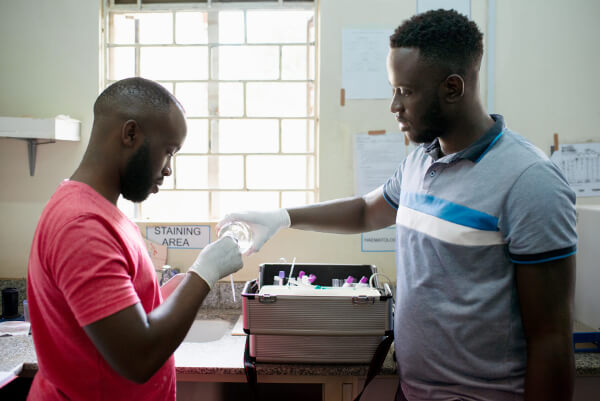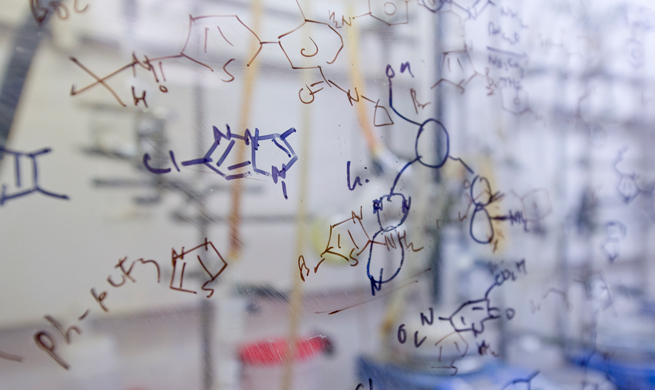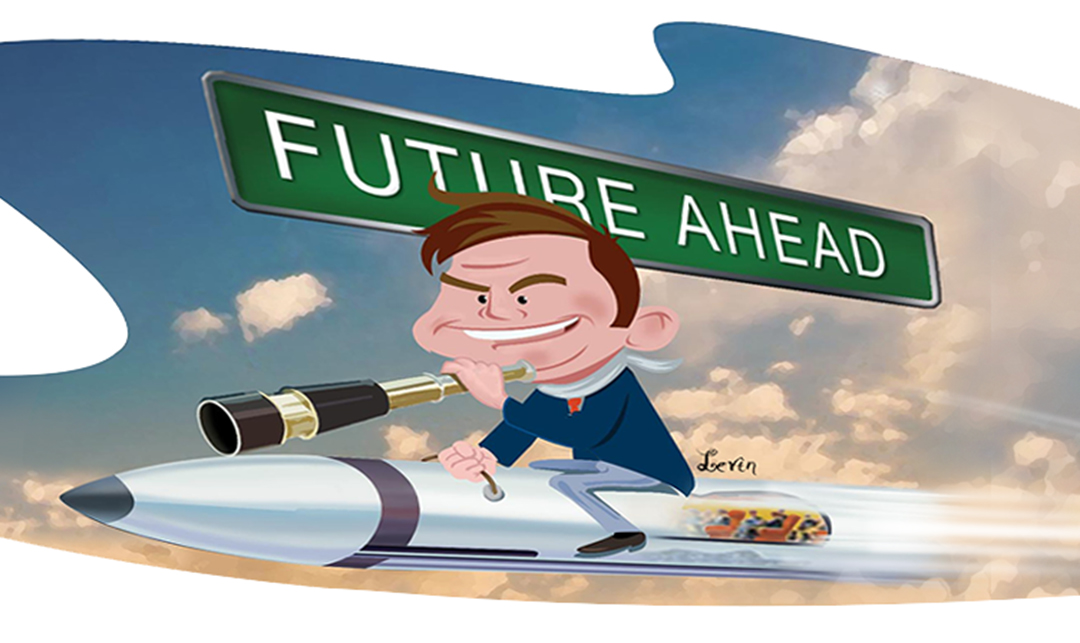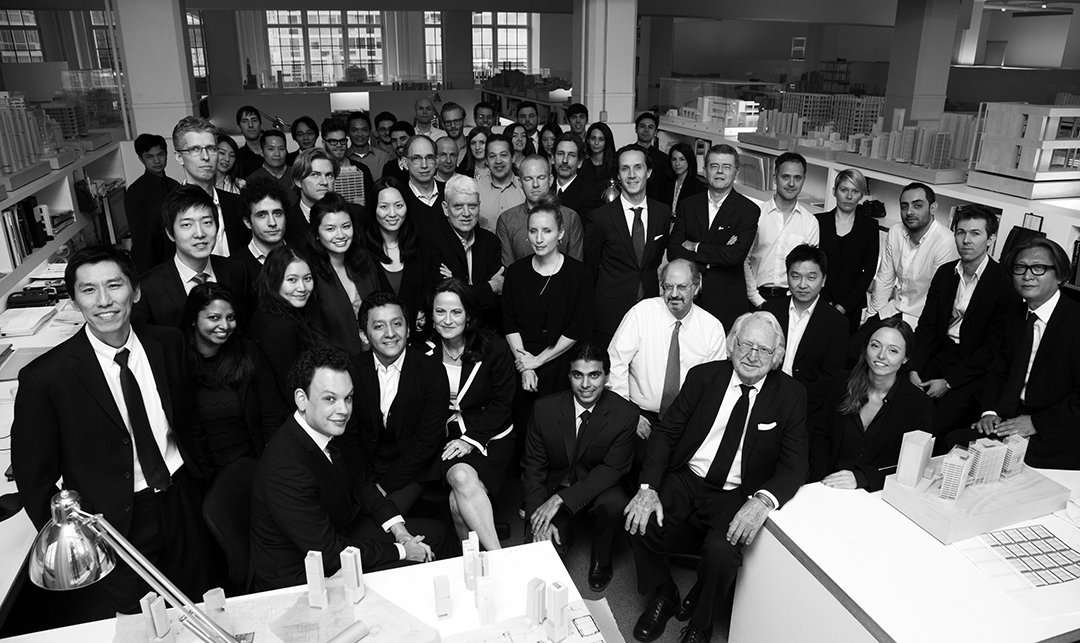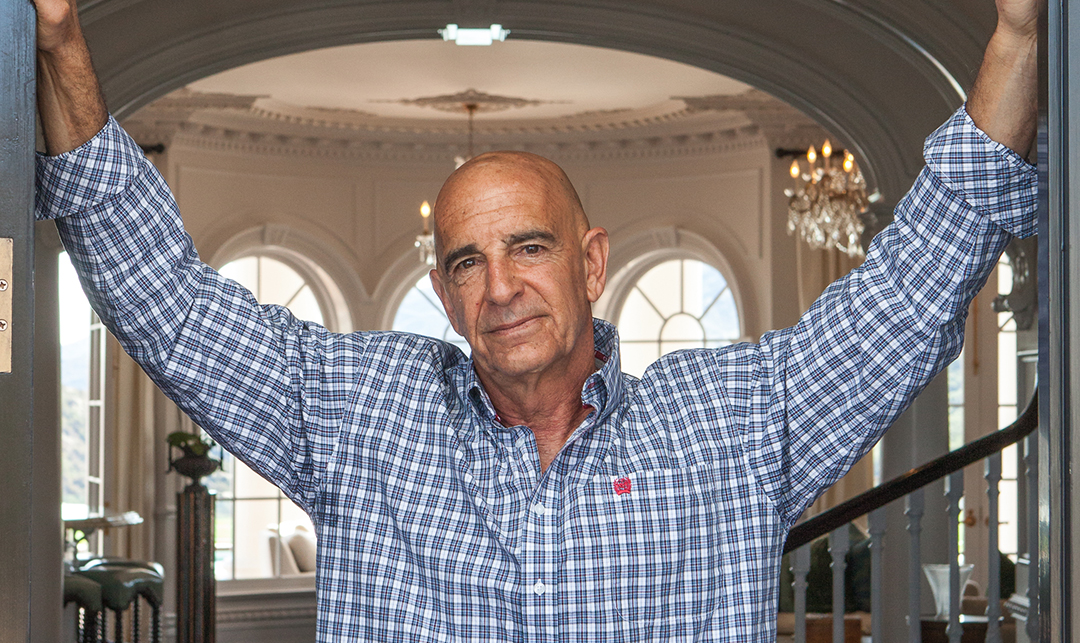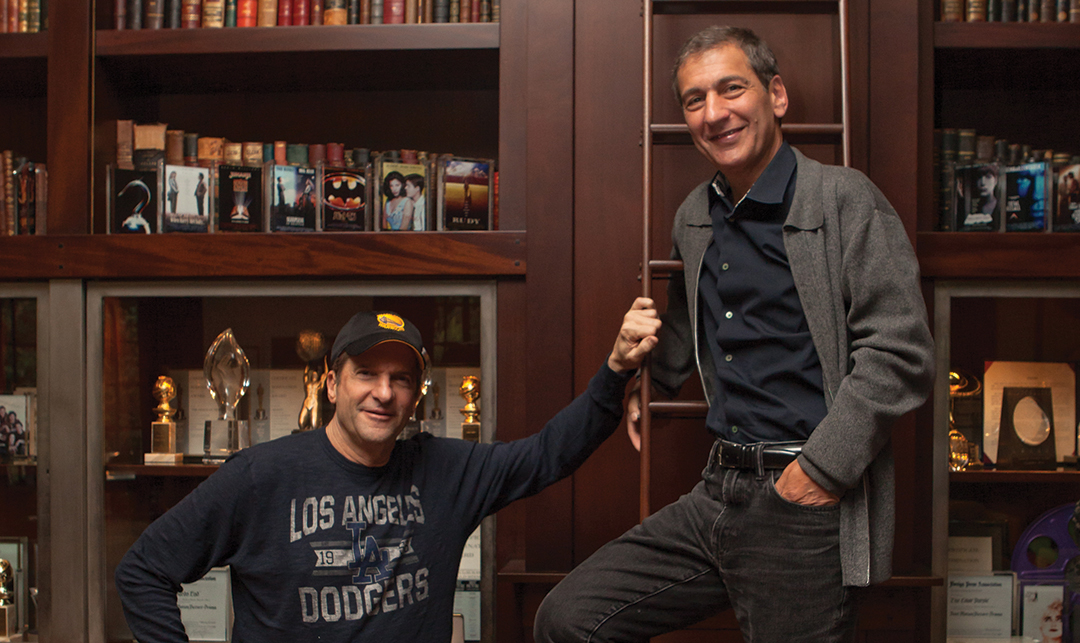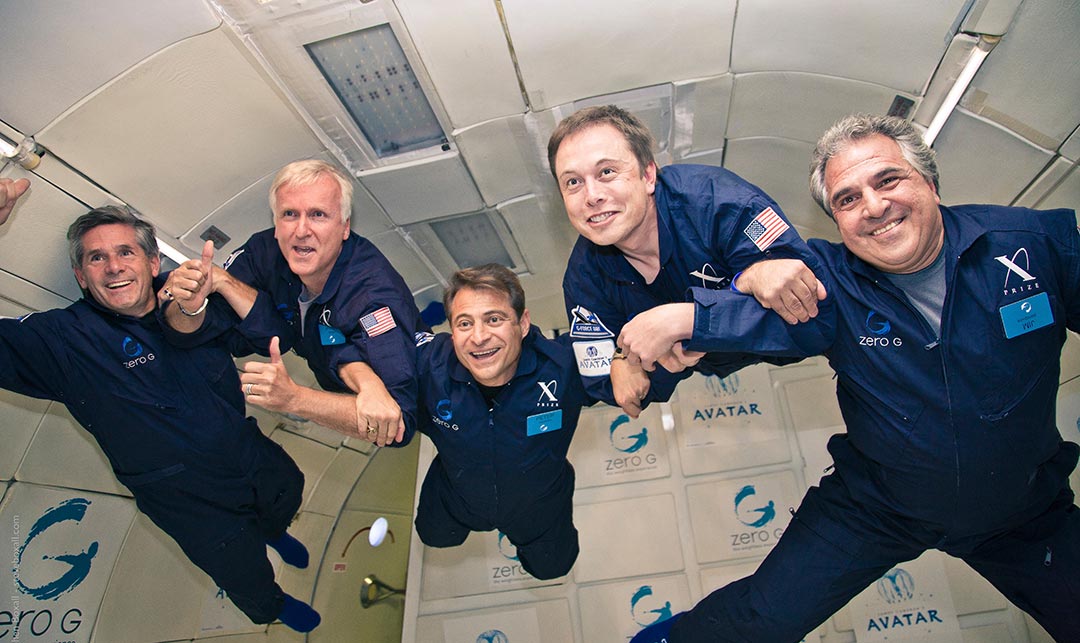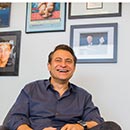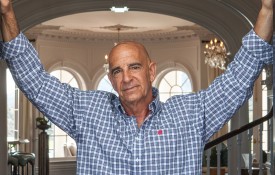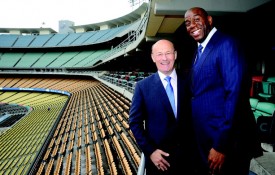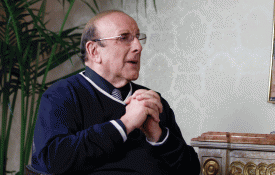“That’s one small step for man, one giant leap for mankind.”
Peter Diamandis was documenting the proceedings on July 20, 1969, when Neil Armstrong stepped out of Apollo 11 and uttered the words that shed perspective on a groundbreaking moment. Armstrong’s memorable moonwalk captivated the eight-year-old, who had his parents’ Super 8 video camera dutifully trained on the television screen, capturing evidence of the feat. “For my future use,” he recalls.
He’s been leaping forward exponentially ever since. Doctor, best-selling author, education corporation co-founder, aeronautical engineer––Peter H. Diamandis (his monogram, fittingly, is PHD) wears all those hats, and that’s not even counting the grand sombrero that constitutes his main gig: XPRIZE Foundation, which for the past two decades has sponsored incentivized contests aimed at solving some of the world’s grandest challenges.
When Diamandis speaks about his bold vision for the future of technology – on Planet Earth and beyond – his magnific declarations are delivered with sobering precision and you soon find yourself open to possibilities: We are able to feed and educate everyone on the planet. We can extend the human lifespan to twice its current expectancy. We will have permanent residences on Mars. Each of these concerns is viewed not through the lens of “if,” but “when.”
Diamandis was not the only child of the ’60s fascinated with outer space. But it’s very likely he was one of the few who gave lectures on the subject to family and neighborhood friends. So impressed was Peter’s father by a talk he gave on the planets that he presented the boy with $5, a substantial sum in those days. “My first revenue earned; my first keynote,” he recalls. “That really impacted me.”
The successful lunar mission of July 1969 was a triumphant capstone on a transformative decade. The human race crossed a threshold from Star Trek science fiction into the orbit of attainable space science. “It set in motion sort of a guiding star for me that drove my passion, my curiosity, and ultimately, the major sequences of my life that brought me to where I’m at [today],” he recollects. With the depth and scope of his pursuits, Diamandis – perhaps more than anyone of his generation – personifies the spirit of the “giant leap for mankind” to which Armstrong was referring.
The 53-year-old entrepreneur is in perpetual motion. Whether strategizing the next XPRIZE with his board (which includes Elon Musk, James Cameron, and Larry Page, among others), carving out the mission of Singularity University (the teaching organization in Silicon Valley that he co-founded with Ray Kurzweil), leading Human Longevity Inc. (a genomics and cell-therapy-based diagnostic and therapeutic company launched in 2014), or guiding the armful of other revolutionary interests he has helped develop, the direction is always full steam ahead. His office at XPRIZE headquarters in Culver City is equipped with a treadmill desk, and he is quite adept at carrying on a discussion while checking emails and walking at a steady clip. There is no time for inertia in Diamandis’ world.
“You’re going to have your food 3D-printed for you at the end of the day with the exact amount of sugars and vitamin D and vitamin A and carbohydrates and proteins that your body needs that day.”
“My plate is abundantly full to the max and I’m loving it,” enthuses the married father of twin boys. “I’m working on exploring the solar system … mining asteroids … extending the human lifespan by 30 or 40 years … solving grand challenges through XPRIZE [via] the variety of prizes we’re launching. There’s nothing I would rather be doing.”
Abundant Dreams
Diamandis was born in the Bronx to Greek immigrant parents who worked in the medical field (his father was an OB-GYN and his mother ran the practice) and believed education to be of paramount importance. The expectation was that Peter would also become a doctor, and he dutifully embarked on that path, appreciative and impressed that his parents, who had come from meager beginnings on a tiny island off the coast of Greece, had pursued the American dream and built a successful life for the family. In 1979 he enrolled in the Massachusetts Institute of Technology (MIT) to study physics and biology. During his sophomore year, Diamandis co-founded Students for the Exploration and Development of Space, the first of an array of organizations he would lead dedicated to furthering his extraterrestrial objectives. Graduating with a B.S. in biology, the next chapter in Diamandis’ academic tome was Harvard Medical School.
Thriving on parallel medical and space science pursuits, his schedule was jam-packed. During his second year in med school, Diamandis founded Space Generation Foundation, which promoted programs and projects dedicated to an inevitable evolution of humanity beyond the bounds of Earth. “My drive for space was in the core of my heart,” he explains. “When something is driven by your core passions, it becomes a lot easier to sleep less, party less, and do more of the things that you want. My favorite memories [involved] running two companies during my last year in medical school.”
On a typical day, he would work night shift at the hospital (10pm–6am), sleep until noon, then go to the office from noon until it was time to go back to the hospital. “It was around the clock. I did get some sleep in there, but I was living my dream.”
Diamandis did complete medical school (although he took a “break” prior to his fourth year to return to MIT, earning his M.S. in aeronautical and astronautical engineering), but he never entered medical practice. By then, he was already a veteran at launching space-based ventures. “I became enamored more by research and entrepreneurship, building businesses around this stuff,” he says. The “stuff” in which Diamandis was dabbling included International Space University (co-founded during his third year in med school), International MicroSpace (a micro satellite launch company co-founded during his fourth year in med school), and a host of other interests that would soon come to fruition. Had he settled on medicine as a career, Diamandis surmises he would have pursued emergency medicine. ”It was really fast-paced, immediately applicable, and useful,” he explains.
X-Ponential Advances
In 1994, Diamandis read “The Spirit of St. Louis,” Charles Lindbergh’s Pulitzer Prize–winning autobiography, which detailed how the aviator’s single-engine monoplane, designed and built in two months’ time, won the $25,000 prize for the first non-stop flight between New York and Paris. The book caused a seismic shift in Diamandis’ thinking. He founded XPRIZE Foundation in 1995 with the mission of crowdsourcing the world’s most brilliant minds to solve grand challenges.
The first XPRIZE competition, announced in 1996, was for a non-governmental organization to launch a reusable manned spacecraft into space twice within two weeks for the purpose of increasing the economic feasibility of space travel. The successful party would be awarded $10 million. On October 4, 2004, 47 years to the day after the successful launch of Sputnik 1, an experimental spaceplane, SpaceShipOne (a replica of which hangs in the lobby at the Culver City headquarters), designed by Burt Rutan and financed by Microsoft co-founder Paul Allen, won the competition. Renamed the “Ansari XPRIZE” earlier that year following a multi-million dollardonation from entrepreneurs Anousheh and Amir Ansari, the contest spurred investment in new technologies in the name of developing low-cost spaceflight.

Diamandis with (left to right) XPRIZE Vice Chairman & President Robert Weiss, Larry Page, and Buzz Aldrin at the Google Lunar XPRIZE launch event on September 13, 2007
“There were 26 teams from seven countries who [collectively] spent $100 million for a $10 million prize,” Diamandis says. “On the heels of it being won – on that day in particular – [there was] a Google Doodle of SpaceShipOne flying over the Google logo.” (A Google Doodle is an alteration of the Google logo that celebrates holidays, anniversaries, and the lives of famous artists, trailblazers, and scientists.) Two weeks later, Google co-founder and president Larry Page invited him to Googleplex and took him to lunch.
Diamandis credits Page with planting the seed to grow XPRIZE into an entity that would address a variety of concerns affecting the human condition. “He said, ‘Let’s expand this. It’s the exponential thing to do’,” recalls Diamandis. “He joined my board, became a Vision Circle member … and we built out a Board of Trustees, which I’m very proud of, from Elon Musk to Wendy Schmidt … to Ratan Tata,” he says, providing an international Who’s Who of notable philanthropic visionaries.
Collectively, XPRIZE has grown to encompass global issues related to ecology, literacy, genomics, health care, and (although an official announcement is still pending) artificial intelligence. To date there have been five XPRIZEs given, with a total of $25.65 million awarded, and one cancelled contest. The 2006 Archon Genomics XPRIZE was discontinued in 2013 when it became apparent that the industry was making substantial strides toward realizing the competition’s goal of greatly reducing the cost and increasing the speed of human genome sequencing. There are currently four active competitions.
“It’s a huge marketplace to sell someone an extra 100 years of life. Healthy life––aesthetics, cognition, and mobility.”
Diamandis points to “Visioneering,” an annual event held to consider future XPRIZE competitions, as a primary conduit guiding the organization’s next steps. Attendees design and pitch innovative, incentivized prize concepts across a variety of Grand Challenge areas, vying for the chance that their idea becomes the next XPRIZE launched. “Every year we [ask] what are the world’s biggest problems? And how do we use incentive prizes to solve those problems? Because it’s now possible for an individual – not a large corporation, not a government agency, an individual – to have access to AI [artificial intelligence], cloud computing, 3D printing, synthetic biology,” he notes. “All of these different fields that were once only the purview of the biggest organizations.”
“There is no problem that we cannot solve,” proclaims Diamandis, seemingly employing “we” in both an individualistic and collective sense. “And solutions can come from anywhere and everywhere.”
Bold New World
Diamandis had just returned from Singularity University’s Exponential Medicine Conference, held Nov. 9–12 in San Diego, when we met at his office, so he was brimming with fresh thoughts gleaned from the event. “I think the biggest revolution we’re going to see is in data science,” he predicts. “I think being able to collect data and mine that data, create algorithms around that data is going to do more for medicine and research than frankly all the life sciences and genetics research that there is.”
He speaks of a not-so-distant future when we will go to the hospital for a medical procedure and demand that the operation be performed not by a human doctor, but rather, “the robot that’s done it perfectly every time.” It’s apparent that although he did not practice medicine, Diamandis has bold opinions that are informed by a deep understanding not only of the profession, but of the direction innovation is heading. “The goal of the next 10 years is we’re all going to become the CEO of our own health,” he predicts. “We’re going to have an AI that’s advising us, [with] access to … the environment, what we’re eating, how much exercise we got, what our blood chemistries are.” Continuous (rather than annual) physical exams will be the norm. “You’re going to have your food 3D-printed for you at the end of the day with the exact amount of sugars and vitamin D and vitamin A and carbohydrates and proteins that your body needs that day. Total transformation,” he summarizes.

Diamandis with (left to right) Suzy and James Cameron and Wendy Schmidt at the 2011 Radical Benefit For Humanity, an event honoring the benefactors and winners of the $1.34 million Wendy Schmidt Oil Cleanup XCHALLENGE
Diamandis was a speaker at the Global Future 2045 Conference in 2013. The 2045 Strategic Social Initiative, founded by Russian entrepreneur Dmitry Itskov in 2011, posits that by the year 2045, “humanity … will make a fully managed evolutionary transition and eventually become a new species.” I ask Diamandis if he thinks consciousness should be immortal, and my brain is reduced to a slack-jawed state as he issues a response that deftly addresses both consciousness and immortality.
“The question is, what is consciousness?” he replies. “What is reality? Why do we only live to 80 years old? Why not 200? Why not 700? Why not indefinitely?
“I was at a dinner at Elon Musk’s house with Larry Page and Sergey Brin having a fun conversation,” he continues, “and my proposition is we are actually living in a virtual existence. And more than that, we’re an ‘n’th generation virtual existence. It’s not the first time. In a universe of 14-and-a-half billion years, are we really the earliest form of life? I think not. I think intelligent life evolved long ago. And I think we are one of many. We’ll save the conversation [as to] where they are. But one posit – and a lot of people agree with me on this – is that this is a virtual existence in the first place. Having said that, it doesn’t really change how you live your life. The question is, why we live to 70, 80, in some cases 100 years old, and that’s a realization that there was never any evolutionary advantage for living longer.
“There are species of animal on this planet that live for hundreds of years,” he continues. “We’ll start to understand why. Why does your body start to deteriorate? Why can a salamander regrow its arm and not you? The proof that this stuff can be done is all around us.… It’s a huge marketplace to sell someone an extra 100 years of life. Healthy life––aesthetics, cognition, and mobility.”
Free Enterprise: The Final Frontier
Artificial intelligence. 3D-printed food. Robot doctors. Driverless cars. Is there anything about innovation, technology, and the future that concerns Diamandis? “Over-regulation,” he admits without missing a beat. “When the government can’t understand something, its reaction is ‘Stop – I don’t understand this, we gotta regulate this, it’s too dangerous.’
“We have 3 billion new minds coming online this decade … represent[ing] tens of trillions of dollars flowing to the global economy. [There’s] an explosion in the amount of innovation coming out of China, India, Pakistan, Africa … parts of the world that we’ve never competed with [and] governments that are much more permissive for reinventing health care or flying drones or whatever the case might be. The U.S. has to be very, very careful [that] it doesn’t over-regulate these technologies and ultimately put the brakes on technology here.”
While he believes that some degree of prudence is necessary, Diamandis contends that consulting with experts in the field, rather than funding freezes, is a more advantageous approach. “When [George W.] Bush was in office, we stopped funding stem-cell research because of moral concerns,” he says. “Put aside the morals and ethics for a moment. All that meant was that the work left the U.S. and went to China, South Korea, other parts of the world, and the U.S. went from being No. 1 to No. 8 in stem-cell work. We live in a world of porous borders and you don’t stop something. It just moves someplace else if there’s energy, momentum, [and] revenue to be made.”
Diamandis’ frustration with governmental red tape intensifies when the subject of space exploration resurfaces. “You’ve got individuals like Elon [Musk], Jeff Bezos, Richard Branson, Paul Allen … who have been extremely successful in one field and were turned on by the vision of space and then so disappointed by how slow things have gone and said ‘Screw it; we’re doing this ourselves.’

Diamandis and George Takei at the XPRIZE offices in Culver City, CA
“I’ve known Elon since his first conversation in this area,” Diamandis says. “He decided to build the launch capability to fulfill his own vision of going to Mars and in the meantime, build a $10 million company that happens to do launches ten times better and three times cheaper than everybody else.”
Diamandis’ optimism concerning the future is reflected in his bestselling 2012 book, “Abundance: The Future Is Better Than You Think,” co-written with Steven Kotler. He notes that in the past 100 years the human lifespan has more than doubled, the per capita income for every nation has tripled and the cost of food and energy has dropped 13 fold and 20 fold, representing substantial progress.
In his latest book, “Bold: How to Go Big, Create Wealth and Change the World,” (also penned with Kotler; see p. 129) to be released in February, Diamandis contends that technology will continue to advance exponentially, and he invokes Moore’s Law as a perpetually attainable state.
Vast potential exists in 3D-printing technology, which is transforming into a $10 trillion industry, says Diamandis. “Any companies that are manufacturing anything need to really be thinking about it.” He goes on to explain that if manufacturing can be done on site and on demand, via 3D printing, shipping and storage become obsolete. “Every single industry is going to be reengineered, probably in the next 10 years.”
Avi Reichental, CEO of 3D Systems (NYSE: DDD), sits on the XPRIZE Innovation Board. He says Diamandis is living proof that audacious ideas are achievable.
“Peter has an abundance of natural curiosity and incredible intellectual depth that enables him to insightfully make the kind of connections that aren’t obvious to most of us,” says Reichental. “He also understands the power of collective wisdom and … has surrounded himself with bold thinkers and doers who act as a force multiplier for his grand challenges.”

Diamandis being interviewed by President Bill Clinton at the 2014 Clinton Global Initiative. During this interview, Diamandis announces the latest prize, the Global Learning XPRIZE
Approaching Singularity
Another of those bold thinkers, whom Diamandis recruited for his XPRIZE Board of Trustees, was inventor / futurist Ray Kurzweil (see pg. 146). While on a backpacking trip to Patagonia – his first vacation in years – Diamandis became immersed in Kurzweil’s book, “The Singularity Is Near,” which delves into exponential technologies and the transformations they are achieving across industries. It got him thinking. “I went to MIT and Harvard – some of the top institutions in the world – and learned from some amazing people,” he says. “But in these institutions, you go really narrow.”
So he pitched Kurzweil on a corporation that would provide educational programs, innovative partnerships, and a startup accelerator to provide understanding of exponentially growing technologies. Kurzweil loved the idea, and in 2008 the pair founded Singularity University. Today, the graduate studies program has 5,000 applicants vying for 80 available slots. There’s also an executive program and a joint venture program between SU and XPRIZE Foundation (the Innovation Partners Program) that caters to senior executive leadership of Fortune 200 companies. “We’re teaching them stuff that either is going to allow them to leapfrog or put them out of business. And they say 80 percent of this is new to them. Which is insane to me. How can they be running these companies without understanding this?”
Diamandis does not anticipate much in the way of innovation from large healthcare companies going forward. “I think they’re going to hold regulations up as their shield,” he predicts. “That will keep them alive for some amount of time, but we’re going to see tech companies, the Apples, Googles, Samsungs, and startups, coming in and transforming health 100 percent.” In short, he says, traditional healthcare companies will be “decimated.”
Taking Flight
With two 3-year-old boys of his own, Diamandis often gets asked about how he is preparing them to face this “going-forward, crazy world,” as he puts it. “I’m not sure that college will be relevant for them in 15 years,” he says. “Continuous learning is an expectation. You don’t go to four years of school and then get a job. No, you may get a job and learn continuously as you go forward, and it’s really about how passionate you are and what you care about.”
Diamandis clearly has no shortage of passion in his life. He transitions smoothly from one interest to another, just like in his college days, but with ever-expanding reach and deepening impact. “If I’m exhausted on asteroid mining,” he says, “I’ll come and have the amazing brainstorm about the future XPRIZES that we’re launching. And then from there, talk about engineering spacecraft to go 100 million miles away. All of this is fun. Is there hard work? Does the shit hit the fan? Often, sure.”
How does Diamandis recharge during his “down time”? He takes to the skies, of course. A licensed pilot, he has a Cirrus SR22 turbo four-seater, stationed at Santa Monica Airport, a three-minute drive from his home. When he flies to Singularity University in Silicon Valley, he can land at Moffett Field and walk to the SU offices, which are located on the same parcel of land.
These brief separations from the terrain afford him the private perspective to further tap into his higher calling with some closing advice to fellow entrepreneurs. “Stop with the meaningless apps and the photo sharing,” he advises. “If you want to become a billionaire, help a billion people. The world’s biggest problems are the world’s biggest business opportunities.”



